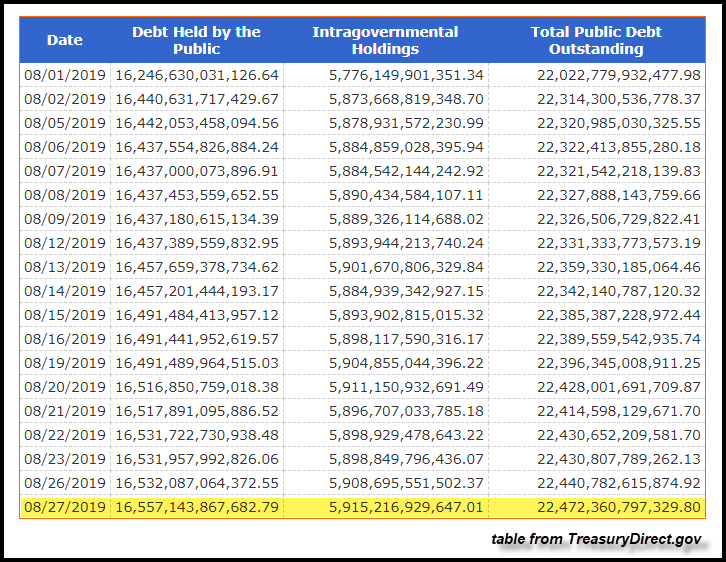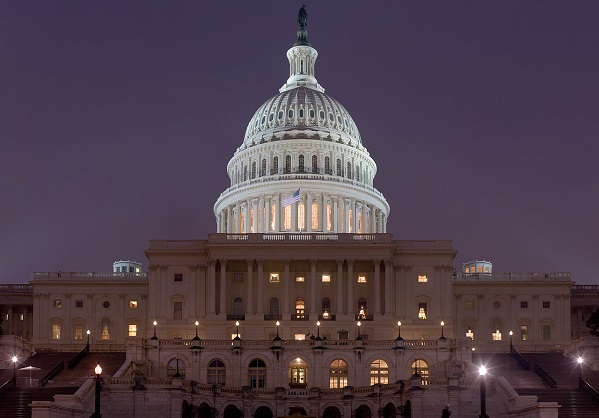US Government Adds Almost Half a Trillion Dollars to National Debt in One Month
The fiscal year budget deficit surged passed $1 trillion last month. Spending deficits necessarily mean more government borrowing and we’re seeing that in the numbers as well. Uncle Sam’s outstanding public debt grew by $450 billion in August alone.
The national debt stood at $22.02 trillion on Aug. 1 and surged to $22.47 trillion as of Aug. 27.

As SRSrocco noted, the huge jump in the debt in August was partly due to the US Treasury making up for lost time. The debt ceiling put a crimp on federal government borrowing until the bipartisan budget deal reached in July suspended the borrowing limit for two years. This was the same deal that will increase discretionary spending from $1.32 trillion in the current fiscal year to $1.37 trillion in fiscal 2020 and then raises it again to $1.375 trillion the year after that. The deal will allow for an increase in both domestic and military spending. So, the spending train keeps right on rolling.
With the deal in place, the US Treasury announced it would issue $814 billion in new debt between August and December.
It’s certainly off to a solid start toward that goal.
Last February, the national debt topped $22 trillion. When President Trump took office in January 2017, the debt was at $19.95 trillion. That represented a $2.06 trillion increase in the debt in just over two years. The borrowing pace continues to accelerate, with the Treasury set to borrow over three-quarters of a trillion more in just six months. (If you’re wondering how the debt can grow by a larger number than the annual deficit, economist Mark Brandly explains here.)
The pundits in the mainstream media tend to focus on the Trump tax cuts as the cause for the surging deficits and growing national debt, but revenues are actually up. Spending is the real culprit. For the fiscal year (beginning Oct. 1), the Trump administration has spent $4.16 trillion. That’s up 7% over last year. Uncle Sam has already spent more this year than it did in the totality of FY 2018.
This is one underlying reason that the Federal Reserve will almost certainly continue efforts to push interest rates lower. The federal government cannot sustain this kind of spending in a high interest rate environment. So far this year, Uncle Same has spent $379 billion simply paying interest on the existing debt. Imagine what that number would look like in anything approaching a normal interest rate environment.
The out of control spending and spiraling deficits are concerning enough on their own terms, but they become absolutely horrifying when you consider that these budget shortfalls are happening during an economic expansion. You would normally expect numbers like this during a major recession.
That raises an important question: what’s going to happen when the recession hits?





 Since Nayib Bukele became president of El Salvador, El Salvador has been in American media and global political discussion more than ever. While much of the attention focuses on Bukele’s mass incarceration of gang members and a decline in homicide of over 70%, Bukele has also drawn attention to his favoritism towards Bitcoin and how he […]
Since Nayib Bukele became president of El Salvador, El Salvador has been in American media and global political discussion more than ever. While much of the attention focuses on Bukele’s mass incarceration of gang members and a decline in homicide of over 70%, Bukele has also drawn attention to his favoritism towards Bitcoin and how he […] With gold hitting yet another awe-inspiring all-time high in the wake of Powell’s remarks reassuring markets (more or less) to expect rate cuts in 2024, a few analysts are pointing out risk factors for a correction — so is there really still room to run?
With gold hitting yet another awe-inspiring all-time high in the wake of Powell’s remarks reassuring markets (more or less) to expect rate cuts in 2024, a few analysts are pointing out risk factors for a correction — so is there really still room to run? Gold hit a new all-time nominal high, surpassing the previous record set in December of the previous year. The precious metal’s price reached approximately $2,140, indicating a robust and continuing interest in gold as a safe-haven asset, despite a rather peculiar lack of fanfare from the media and retail investors. This latest peak in gold […]
Gold hit a new all-time nominal high, surpassing the previous record set in December of the previous year. The precious metal’s price reached approximately $2,140, indicating a robust and continuing interest in gold as a safe-haven asset, despite a rather peculiar lack of fanfare from the media and retail investors. This latest peak in gold […] The gold price has been surging, with unprecedented central bank demand gobbling up supply. It has been a force to behold — especially as US monetary policy has been relatively tight since 2022, and 10-year Treasury yields have rocketed up, which generally puts firm downward pressure on gold against USD.
The gold price has been surging, with unprecedented central bank demand gobbling up supply. It has been a force to behold — especially as US monetary policy has been relatively tight since 2022, and 10-year Treasury yields have rocketed up, which generally puts firm downward pressure on gold against USD.  Total gold demand hit an all-time high in 2023, according to a recent report released by the World Gold Council. Last week, the World Gold Council (WGC) released its Gold Demand Trends report, which tracks developments in the demand for and use of gold around the world. Excluding over-the-counter (OTC) trade, 2023 gold demand fell slightly from 2022 […]
Total gold demand hit an all-time high in 2023, according to a recent report released by the World Gold Council. Last week, the World Gold Council (WGC) released its Gold Demand Trends report, which tracks developments in the demand for and use of gold around the world. Excluding over-the-counter (OTC) trade, 2023 gold demand fell slightly from 2022 […]